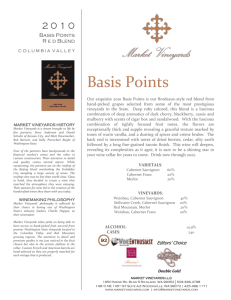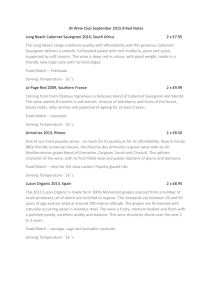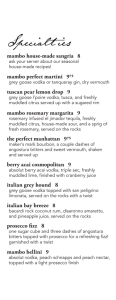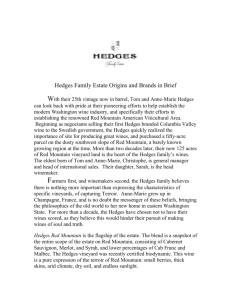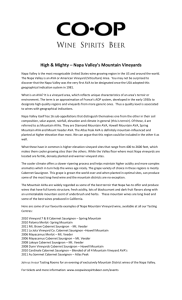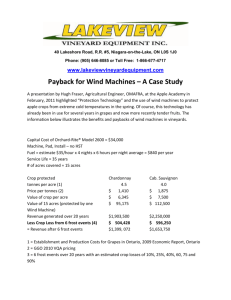Cabernet Sauvignon fruit yield and quality
advertisement
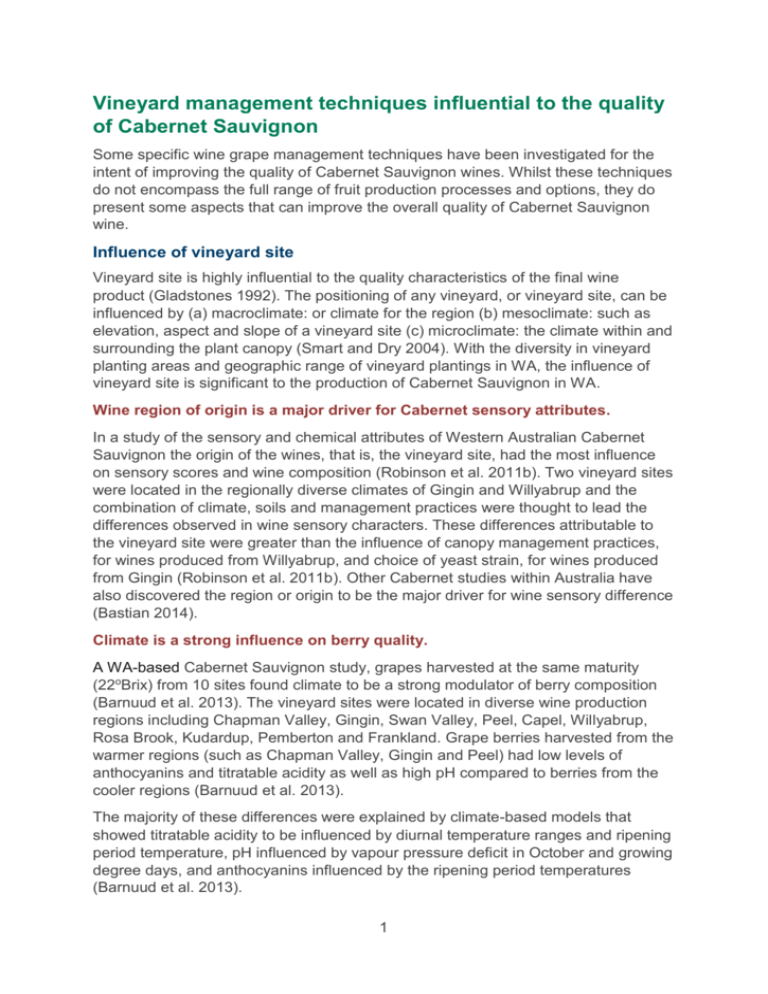
Vineyard management techniques influential to the quality of Cabernet Sauvignon Some specific wine grape management techniques have been investigated for the intent of improving the quality of Cabernet Sauvignon wines. Whilst these techniques do not encompass the full range of fruit production processes and options, they do present some aspects that can improve the overall quality of Cabernet Sauvignon wine. Influence of vineyard site Vineyard site is highly influential to the quality characteristics of the final wine product (Gladstones 1992). The positioning of any vineyard, or vineyard site, can be influenced by (a) macroclimate: or climate for the region (b) mesoclimate: such as elevation, aspect and slope of a vineyard site (c) microclimate: the climate within and surrounding the plant canopy (Smart and Dry 2004). With the diversity in vineyard planting areas and geographic range of vineyard plantings in WA, the influence of vineyard site is significant to the production of Cabernet Sauvignon in WA. Wine region of origin is a major driver for Cabernet sensory attributes. In a study of the sensory and chemical attributes of Western Australian Cabernet Sauvignon the origin of the wines, that is, the vineyard site, had the most influence on sensory scores and wine composition (Robinson et al. 2011b). Two vineyard sites were located in the regionally diverse climates of Gingin and Willyabrup and the combination of climate, soils and management practices were thought to lead the differences observed in wine sensory characters. These differences attributable to the vineyard site were greater than the influence of canopy management practices, for wines produced from Willyabrup, and choice of yeast strain, for wines produced from Gingin (Robinson et al. 2011b). Other Cabernet studies within Australia have also discovered the region or origin to be the major driver for wine sensory difference (Bastian 2014). Climate is a strong influence on berry quality. A WA-based Cabernet Sauvignon study, grapes harvested at the same maturity (22oBrix) from 10 sites found climate to be a strong modulator of berry composition (Barnuud et al. 2013). The vineyard sites were located in diverse wine production regions including Chapman Valley, Gingin, Swan Valley, Peel, Capel, Willyabrup, Rosa Brook, Kudardup, Pemberton and Frankland. Grape berries harvested from the warmer regions (such as Chapman Valley, Gingin and Peel) had low levels of anthocyanins and titratable acidity as well as high pH compared to berries from the cooler regions (Barnuud et al. 2013). The majority of these differences were explained by climate-based models that showed titratable acidity to be influenced by diurnal temperature ranges and ripening period temperature, pH influenced by vapour pressure deficit in October and growing degree days, and anthocyanins influenced by the ripening period temperatures (Barnuud et al. 2013). 1 Vineyard site opportunities Investigate the influence of vineyard site and viticulture management on tannin development in Cabernet Sauvignon. Soil type – regional soils of WA Studies of Cabernet Sauvignon vines grown on different soil types have found soil to be a key determinant of vine performance and fruit quality (Davidson 2007) influencing wine phenolic composition and tasting characteristics (Ubalde et al. 2010). Due to the distance between wine production regions in WA, the soil types where grapevines are grown are diverse and range from deep sands to heavy clays. Information on Cabernet Sauvignon’s interaction with soil type in WA is limited. The most predominant soils used for wine grape production in WA are the ironstone gravelly soils that are prevalent throughout the south west and encompass duplex sandy gravels, loamy gravels, deep sandy gravels and shallow gravels (Schoknecht 2002, Tille 2014). Fertile red/brown loam soils are also found throughout the south-west, predominantly in valley floors with alluvial sands and loams commonly found along major rivers occurring frequently in the Swan Valley, west of Harvey and the Jindong area (Tille 2014). Deep sandy soils, such as yellow, brown and red sands can be found in vine production on the Swan Coastal Plain and also occur from Geraldton to Busselton. Sandy duplex soils, often found on hillslopes and common to the Swan Coastal Plain together with the pale, deep, grey to white sands are generally not preferred for viticulture however can be widespread and often occur among isolated vineyard pockets (Tille 2014). These soils often have low levels of organic matter, poor nutrient and moisture-holding capabilities. Soil type opportunities Further investigation of Cabernet Sauvignon’s interaction with soil type. Which soil types are suited to the premium production of Cabernet? Cabernet Sauvignon plant material The establishment of grapevine planting material for the production of quality wine grapes is an important consideration in commercial viticulture. Numerous aspects contribute to the production of quality grapes however the choice of grapevine planting material is fundamental to the establishment of productive vineyards. Cabernet Sauvignon clones A diverse range of Cabernet Sauvignon clones is available for propagation in WA. These clones include selections that have been made in WA (such as the Houghton clones) and those made interstate (including South Australia) and overseas (California). Cabernet clone SA126 has predominately been an industry standard used for Cabernet production in WA with up to 70% of plantings thought to be of this clone (Ward and Cameron 2013). Other commercially produced clones from international 2 selections have been imported and produced by private nurseries such as Mercier 191 and 337 (Ward and Cameron 2013). Eight Cabernet sauvignon clones are currently available for propagation in WA from the Western Australian Vine Improvement Association. These include LC9, LC10, LC14, LC84, SA125, SA126, G9V3, CW44 (WAVIA 2013). Up to 70% of WA Cabernet plantings are thought to be clone SA126. In recent Cabernet Sauvignon clone research in WA, superior clones were evaluated and selected for premium wine production. Twenty clones selected from Houghton’s vineyard in the Swan Valley from 1968 to 1970 were planted in Frankland in 1973 and evaluated from 2008 to 2012. These Cabernet Sauvignon clones were evaluated for viticulture attributes, winemaking and wine sensory characteristics. Results identified Cabernet Sauvignon clones 5 and 9 to have very high commercial potential being suitable for all regions; Clone 20 as having high commercial potential, most suited to high vigour sites; and Clone 19 with medium commercial potential, most suited to non-irrigated vineyards (Ward et al. 2013). In South Australia, nine Cabernet Sauvignon clonal selection and evaluation trials were conducted from 1958 to 1988 with the aim of improving productivity of the variety then known for its low yields. Initial evaluation began in Nuriootpa where 180 vines were assessed for yield for a period of five years where the average yield per vine ranged from 0.1 to 3.4kg (Cirami et al. 1993). High yielding clones were found to be the Barossa Valley selections of SA125 and SA126 (Cirami et al. 1993). Subsequently, SA126 was introduced into WA in 1969 to become the major Cabernet Sauvignon clone in the state, currently accounting for 70% of plantings (Ward and Cameron 2013). SA125 became known for the herbaceous characters that it could produce in wines, more than other clones, with SA126 imparting less herbaceous and more fruit-driven characters in wine (Whiting 2003). Cabernet Sauvignon clone evaluation and selection is also performed internationally. Organisations in France, Italy, Germany, North and South America have initiated clone evaluation and selection programs. Of note, is the clone work undertaken by Foundation Plant Material Services (FPMS) in California. FPMS have obtained Cabernet Sauvignon clones from numerous sources within California and other countries, such as Argentina, Chile, France, Italy and Germany (Gollino 2008). Some clone selections, such as FVG9V3, have been imported into Australia and, once trialled, were found to consistently yield well, producing fruit-driven wines with low levels of herbaceous characteristics (Cirami et al. 1993, Whiting 2003). It is well known that viticultural and oenological characteristics of Cabernet Sauvignon can differ between clones. Differences have not only been detected in fruit yield and wine sensory characters, but also in wine chemical characteristics and vine components. Clone research has been conducted within Australia and other wine producing regions throughout the world. Differences in phenolic content and colour composition have been found in clones (169 and 685) in Brazil (Burin et al. 2011) and in vine characteristics (yield and growth habit); leaf characters (ampelographic assessment); 3 cluster characters (level of compaction); berry characters (colour, size, shape, maturity, pH); flavour characters (including anthocyanins, colour) and wine characters (wine sensory perception) in California (Gollino 2008). Differences between the Cabernet Sauvignon clone selections may be related to genetic differences in the plant material. The genetic diversity of many clones has been investigated in France (Moncada et al. 2006, Pelsy et al. 2010). One study, which included Australian clones, suggested France to be the origin of Cabernet Sauvignon diversification showing the genetic divergence of the variety to be due to chimerical structure (Moncada et al. 2006). Cabernet Sauvignon is thought to originate from the crossing of Cabernet Franc and Sauvignon Blanc in the 17 th century in France (Bowers and Meredith 1997). To further investigate Cabernet Sauvignon in Australia, a study of the genomic basis of clonal variation in Cabernet Sauvignon wine grapes is being undertaken in an Australian Research Council funded project chiefly investigated by The University of Western Australia and partnered by the Department of Agriculture and Food, WA Vine Improvement Association, The Yalumba Wine Company and the Australian Wine Research Institute. This project utilises cutting edge molecular profiling to design methods to map the identity of grapevines in whole vineyards, enabling industry to capture this variation for crop improvement. This project commenced in 2014 for three years. Cabernet Sauvignon clones further opportunities Determination of earlier ripening and higher yielding clones Investigation of the effect of yield on quality (vine balance) with a variety of clones Regional clone identification The effect of growing and making wine from a single clone (monoculture) versus blend of clones for most consistent fruit and wine over time Investigation on which clones work best, and where these clones should be grown The effect of virus loads from grafting over to new clones: including (i) new Houghton clones on SA126/SA125 and (ii) new Houghton clones on other varieties. Rootstocks for Cabernet Sauvignon production The majority of wine grapes grown in the South-West of Western Australia (WA) are planted on their own roots (Gladstones 1992). Rootstocks are known to influence grapevine vigour and fruit quality which can impact the final wine product (Ough et al. 1968, Ewart and Sitters 1989). They are also known to assist in limiting situations by preventing economic damage associated with nematodes and phylloxera (Pongrácz 1983). Rootstocks are influential in situations where salinity, drought and/or where limiting soil characteristics are a factor (Whiting 2004). In WA, the lack of rootstock information specific to WA conditions together with the additional cost of using rootstocks during vineyard establishment led many vignerons to discount their use. 4 Limited information about Cabernet Sauvignon production on rootstocks in Western Australia exists. Previous WA Cabernet rootstock evaluations have shown difficulty in establishment. In other states, Cabernet Sauvignon was found to perform well when grafted to 5C Teleki and 140 Ruggeri in Sunraysia (Krstic and Hannah 2003). Cabernet Sauvignon grafted to Ramsay and 110 Richter in Langhorne Ceek produced wines with colour density and phenolics in the lower range, although these figures were in the higher range for Cabernet Sauvignon grafted to 5C Teleki and Schwarzmann (Gawel et al. 2000). Aroma and flavour intensity were greater with 5C Teleki, Schwarzmann and ungrafted vines, compared with Ramsay and 110 Richter (Gawel et al. 2000). Cabernet Sauvignon fruitfulness and bunch number were higher when grafted to Ramsey, 1103 Paulsen and Schwarzmann in a cool climate (Kidman et al. 2013). Most rootstock research results have been compiled into the development of the Yalumba Rootstock Selector that is available online and considers rootstock selection aspects such as vineyard location, variety, water, growth requirements, soil and pests. Wine producers in WA that seek information on the performance of rootstocks therefore primarily rely on conclusions made from interstate and overseas rootstock trials established in a variety of growing conditions. Conflicting results of rootstock performance may arise from these comparisons (May 1994, Morton 1994). Rootstock opportunities Investigate the rootstocks suited to WA conditions and high quality Cabernet wine production. Cabernet Sauvignon fruit yield and quality The fruit yield of Cabernet Sauvignon grapevines is influenced by a multitude of factors. These include the age of the vine, pruning method, vigour, site characteristics (such as soil type, irrigation, vine nutrition, climate, light availability/intensity) canopy management practices (including trellis type, fruit thinning) irrigation and clone. As such, the fruit yield can be highly variable and is often manipulated in order to achieve a desired crop load that meets a targeted wine style and is able to satisfy winery and market demands. The relationship of Cabernet Sauvignon fruit yield to wine quality can be based on management’s expertise within a given vineyard or subjective ideals of the yield to provide a given fruit and wine quality result. Numerous studies have investigated the effects of site characteristics and grapevine management practices on the yield of Cabernet Sauvignon vines. However, information on the fruit yield of Cabernet Sauvignon in relation to fruit and wine quality is scant. Given all the factors that contribute to the fruit yield of grapevines, the capacity of the grapevine to achieve optimal ripeness of the grapes that it produces is limited. That is, grapevines have the ability to produce a certain amount of vegetative growth and ripen a certain quantity of fruit in any one season (Keller 2010). The concept of sustainable grape production in relationship to grapevine growth and yield is 5 important (Howell 2001). As such, the notion of vine balance is prevalent in wine grape studies. High yielding vines can produce high quality Cabernet fruit. Interestingly, many studies of Cabernet Sauvignon grapevine yield in relationship to wine quality have discovered some high yielding grapevines to produce high quality and desirable fruit and wine characters. The bitterness and astringency of Cabernet Sauvignon wines was ranked higher in wines made from low yielding vines that those made from high yielding vines (Chapman et al. 2004a). Cabernet Sauvignon wines produced from low yielding vines displayed high ‘veggie’ and ‘bell pepper’ aromas, ‘bitterness’ and ‘astringency’ mouth feel (Chapman et al. 2004a). High yielding vines were found to produce fruit for wines high in ‘blackberry’ and ‘jam’ aromas and ‘fruity’ flavour (Chapman et al. 2004a). As grapevine yield increased the ‘fruity’ characteristics in wine increased and the ‘veggie’ characters decreased which is also related to the green characters imposed by methoxypyrazines (Chapman et al. 2004a). A five-fold increase in yield for Cabernet Sauvignon found the pH and titratable acidity of juice to be unaffected (Clingeleffer 1989). As such, yields of up to 26t/ha have not been found to reduce wine quality in Cabernet Sauvignon (Bravdo et al. 1985). Fruit yield to pruning weight ratio is a useful tool for quality Cabernet production. The grape yield to pruning weight ratio, also known as the Ravaz index, is useful for consistent production of quality fruit. The yield to pruning weight ratio was first developed by Ravaz in 1911 and has since been used as a method that can be easily adopted to measure the balance between the production of mature, ripened fruit and the vegetative growth that supports this (Howell 2001). Vines with high vigour have low yield to pruning weight ratios (<3), low vigour vines have high yield to pruning weight ratios (>12) and moderate vigour has values of between 5 to 10 (Smart and Robinson 1991). Studies of Cabernet Sauvignon overseas have found the use of fruit yield to pruning weight ratio to be ideal in measuring grape and furthermore wine quality (Bravdo et al. 1985, Kliewer and Dokoozlian 2005). For Cabernet fruit production, Bravdo et al. (1985) found a yield to pruning weight ratio of up to 10 was a good measure of wine quality. Above this level, the ratio became too high and resulted in a reduction of quality. Further investigation found that a yield to pruning weight ratio of between 4 and 10 was required to ripen fruit, which equated to a leaf area of 2 to 5 square metres (Kliewer and Dokoozlian 2005). As such, in Cabernet Sauvignon, 0.8 to 1.2 square metres of leaf area per kilogram of fruit was required to ripen fruit (Kliewer and Dokoozlian 2005). Of interest in the concept of grapevine fruit production and canopy balance is the effect of low fruit yields on the functioning of the vine. That is, source-sink relationships within the grapevine based on the fruit being a metabolic sink can be affected by a lack of fruit in relationship to excessive leaf, shoot and lateral growth. This can lead to high carbohydrate accumulation and a feedback inhibition of 6 photosynthesis (Palliotti et al. 2012). Therefore the leaf area to fruit weight ratio needs to be in balance in order to avoid the creation of unbalanced situations that result in excessive canopy growth that requires addition management and financial resources to manage (Palliotti et al. 2012). Cabernet fruit yield and quality opportunities To investigate the optimal yield to pruning weight ratio and leaf area required for ripening and production of premium Cabernet fruit for WA conditions. More information on the effect of Cabernet Sauvignon yield on quality (vine balance) with a variety of clones is required. Time of harvest/fruit maturity/hang time A number of measurements are available to determine the maturity of grapes. These include sugar maturity, grape colour intensity, pH, acidity, phenolics, aroma and flavour compounds. However the determination of grape maturity is more often made by the grape producer and/or winemaker based on the intended use of the grapes, style of wine to be produced and what is typical for a variety in a given region and year (Hellman 2004). The wine grape producer and or winemaker determine the harvest date based on fruit flavours, season and environmental conditions. The decision to harvest wine grapes also encompasses numerous factors that are not based solely on the maturity of the fruit and include seasonal weather conditions, labour and winery schedules, fruit integrity and condition. Recently, the concept of ‘hang time’ in relation to the harvesting of grapes has become common. In some wine production regions ‘hang time’ can refer to the extended ripening of grapes to achieve ripe fruit flavours. Consequently, such practices lead to high sugar maturities and lower acid in fruit with high alcohol contents in wine (Hellman 2004). Whereas, other wine regions refer to ‘hang time’ as the period of grape ripening prior to harvest based on achieving desired fruit characters that are in balance with sugar, acid, colour and tannins for a given season. In Cabernet Sauvignon wine production the early harvest of grapes is associated with the production of wines with ‘green’ related vegetative aromas and flavours. As the ripening of Cabernet Sauvignon grapes progresses, the aromas and flavours evolve from ‘green’, ‘unripe’ related characters to ‘red fruit’, ‘black fruit’ and ‘jam’ related characters shown in Figure 1 (Bisson 2001). Figure 1 Evolution of flavourants in Cabernet Sauvignon grapes (from Bisson 2001) 7 A number of important compound classes concurrently alter with the ripeness of grapes. Anthocyanins, tannins and norisoprenoids can reach a peak, or threshold, during ripening (Heymann et al. 2013). In Cabernet Sauvignon, the anthocyanin and tannin concentration in grape skins increases as ripening progresses, whilst the tannin in seeds decreases (Bindon et al. 2013). These characters further transfer to the wines with anthocyanins and tannin concentrations increasing with the harvest date (Bindon et al. 2013). Studies of the effect of increased ‘hang time’ on the characteristics of Cabernet Sauvignon wines are limited. A recent Australian study investigated the effect of harvest time and wine composition for Cabernet Sauvignon grapes. Wines were produced from grapes that were harvested at various maturities producing wines ranging from 12 to 15.5% alcohol. It was found that wines produced from riper grapes had increased attributes of ‘dark fruits’, ‘hotness’ and ‘viscosity’ with a corresponding decrease in the attributes of ‘red fruit’ and ‘fresh green’ characters (Bindon et al. 2014). Consumer testing discovered that those wines lower in alcohol (12%) were preferred less than those higher in alcohol (13% and 15.5%). The optimal sugar maturity was found to be at 25o to 26o Brix. In California, researchers investigated the effect of increased ‘hang time’ (from 21 to 30o Brix) on the sensory characteristics of Cabernet Sauvignon wines. Wines produced from grapes at lower sugar maturities contained more ‘sour’ and ‘vegetative’ flavours while those produced from high sugar maturities had more ‘hot’, ‘bitter’ and ‘dark fruit’ flavours (Heymann et al. 2013). The wine sensory attributes were found to differ more when wines were produced from grapes harvested lower than 24o Brix with the optimal sugar maturity determined at 25 to 26o Brix (Heymann et al. 2013). However, extended ripening and ‘hang time’ can result in decreased yield due to berry dehydration (McDonnell et al. 2008) and shrivel. Time of harvest opportunities The concept of ‘hang time’ in the production of Cabernet wines to be investigated further. What are the consequences for fruit and wine quality produced from a range of fruit ripeness in WA conditions? Irrigation – including vine stress Cabernet Sauvignon is produced in WA either with or without supplementary irrigation. Rain-fed grape growing occurs predominantly in the South-West on established Cabernet Sauvignon vines. Irrigation is adopted by wine grape producers in order to apply water during periods of inadequate rainfall and to produce adequate yields. For irrigated vineyards, regulated deficit irrigation (RDI) is a common irrigation technique that is employed to manage water stress and to irrigate at less than the vines water requirement (Campbell-Clause and Fisher 1999). Irrigation practices of Cabernet Sauvignon grapevines during periods of reduced water availability have been investigated in Australia. A three-year study of sustained deficit irrigation (SDI) practices implemented in the Murray-Darling Basin in South 8 Australia in response to water restrictions, drought and competing water uses investigated the effects of SDI on wine colour (Chalmers et al. 2010). Cabernet grapevines were drip irrigated at 100% of estimated of evapotranspiration rate (control) and three water deficits of 70, 52 and 43% of the control (Chalmers et al. 2010). Wines produced showed the anthocyanin, colour density and phenolic concentrations to increase with increasing intensity of SDI (Chalmers et al. 2010). In Australia, the long-term use of RDI and prolonged water deficit (PD) in the warm climate wine production area of Sunraysia, Victoria, was found to reduce yield and canopy size results that were stable over multiple seasons (Edwards and Clingeleffer 2013). Both RDI and PD treatments improved fruit and wine composition to a limited degree (Edwards and Clingeleffer 2013). Overall, the long-term use of RDI was found to be unlikely to affect the long-term decline in vine productivity. However, their research suggested that there currently is limited understanding of how RDI controls vine vigour (Edwards and Clingeleffer 2013). Studies of irrigation management of Cabernet Sauvignon overseas showed different irrigation management techniques to affect yield and fruit quality. Cabernet Sauvignon vines grown in Napa Valley were subjected to drip irrigation strategies of minimal irrigation (i.e. no irrigation added unless water potential below 1.6MPa), standard irrigation (32 litres of water per vine per week) and double irrigation (64L of water per vine per week) by Chapman et al. in 2005. Wines made from fruit of vines subjected to water deficits were found to have higher fruity and less vegetal aromas and flavours than those produced from vines with higher irrigation (Chapman et al. 2005). This may have been influenced by the variable yields that were found between irrigation treatments that ranged from a low of 15 tonnes per hectare for the minimal irrigation treatment to a high of 27.1 tonnes per hectare for the double irrigation treatment (Chapman et al. 2005). Those wines made from the minimal irrigation treatment were higher in fruit flavour and blackberry, jam and dried fruit aroma (Chapman et al. 2005). Studies from Spain show the effect of water stress in Cabernet Sauvignon to vary depending on the timing and degree of water stress applied. Water stress applied from flowering to full fruit set was disadvantageous as this resulted in a decrease in yield, total soluble solids, anthocyanins and polyphenols (Basile et al. 2011). Whereas, water stress applied from the stage of 60% veraison to harvest was shown to increase anthocyanin and polyphenol concentration (Basile et al. 2011). 9

